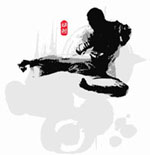|
Chapter 6. The principles of Taekwondo be simple "Why should I make low pose?" "Because it represents humility. Humble one will not be despised."
As every true Taekwondo man
knows, the ultimate figure of Taekwondo is a simple skillart, a simple mind,
and a simple reality. A large number of extremities are hidden in this one
simple figure. Just as This mysteriousness of TAEKWONDO appears in Taekwondo, too. A competition finishes when you fell down your opponent no matter what kind of swift skill you may use, but you have to practice various kinds of skills and exercise complicated movements for that one skill. By the way, the simple motion, without those trainings and exercises, can not be performed nor can it work to the opponent. That's because the simple motion can be performed only through all the trainings integrated in you. This kind of right principle of Taekwondo is that "everything of yourself should be kept on its own place, i.e. its most proper position in continuous change". The most proper position of everything moves in interrelations with everything else, so everything of yours has to keep moving in the best harmony with all anothers. This principle is called "the way of Haneul(Sky)"1) in Taekwondo. The fact that everything of yours is posited on its own proper place implies not simply that each hand and each foot with each part of your body is posited properly but also that everything in literal sense, including your mind, intention, speed, breath, sight and so on, is in the best composition. This thought brings now the most simple principle of right Taekwondo, that everything should be posited on its own place, to the infinitely complicated one, relying on what conditions you may have, what kind of man your opponent is, and in what situation you meet him. This shows that simpleness and complex precision are same in Taekwondo. The most proper position of a thing is not fixed but to be determined in the harmony with others. Therefore, everything of Taekwondo moves changefully and to the right position like the world that continues its change. Thus, Taekwondo can apply itself to everything. On the other hand, the proper position is to be determined not at random but along its own evident order and law, even in changeful flows. This is how TAEKWONDO can have its unchangeable figure in running time. Whatsoever it might be named and conceived, but the word or the name is not important here. Thus, when everything of Taekwondo man is posited on its own proper place he can keep his power never swayed even in whatever chaos if needed and adjust himself to every flow concealing his power under feather-like softness sometimes. And, when necessary, he can meet his opponent in a stay with perfect equipment of his body, and sometimes can he attack his opponent's blind point in swift motion, while he mixes his movements into the opponent's by way of the same motion another times. On the other hand, there can be no unnecessary movement in Taekwondo man's motion with everything kept in its own proper position. Therefore, right Taekwondo just moves from one pose or motion to another with nothing at all between them. It is a principle of Taekwondo that everything be kept its own proper position, which can be extended over to principle of society and that of man general in consistency. The perfect society can be made when social states, capabilities, and rights of citizen are distributed and posited properly. We can settle good etiquette and morality when we construct a good network of words and actions, attitudes and understandings, intentions and relations positing them properly. When everything of yours
occupies its own proper position there is nothing that is not you in you.
So, there is nothing to discard in you not only concerned with Taekwondo
but also with something else. This has been extended conceptually to be
regarded as doing of not doing( In this way, the principles of Taekwondo are same with others in essence although its figure seems to be different from those of others. It is simple and natural that everything is posited on its proper place, which is enormously difficult for those who don't know TAEKWONDO yet rather easy for those who know TAEKWONDO. That the difficult and the easy are same in the simple, it is the true. <footnotes>
1) The Korean term "Haneul" refers
to the sky or the heaven firstly. But it also includes the meaning of oneness
with bigness and the god as the whole universe. "Han-" is based
on the same etymology of "Hana"(One) in Korean and "Khan"
in Mongolian term. Thus, the meaning of "Haneul" can be said "the
big and only universe or universal principle, symbolized by the sky."
|